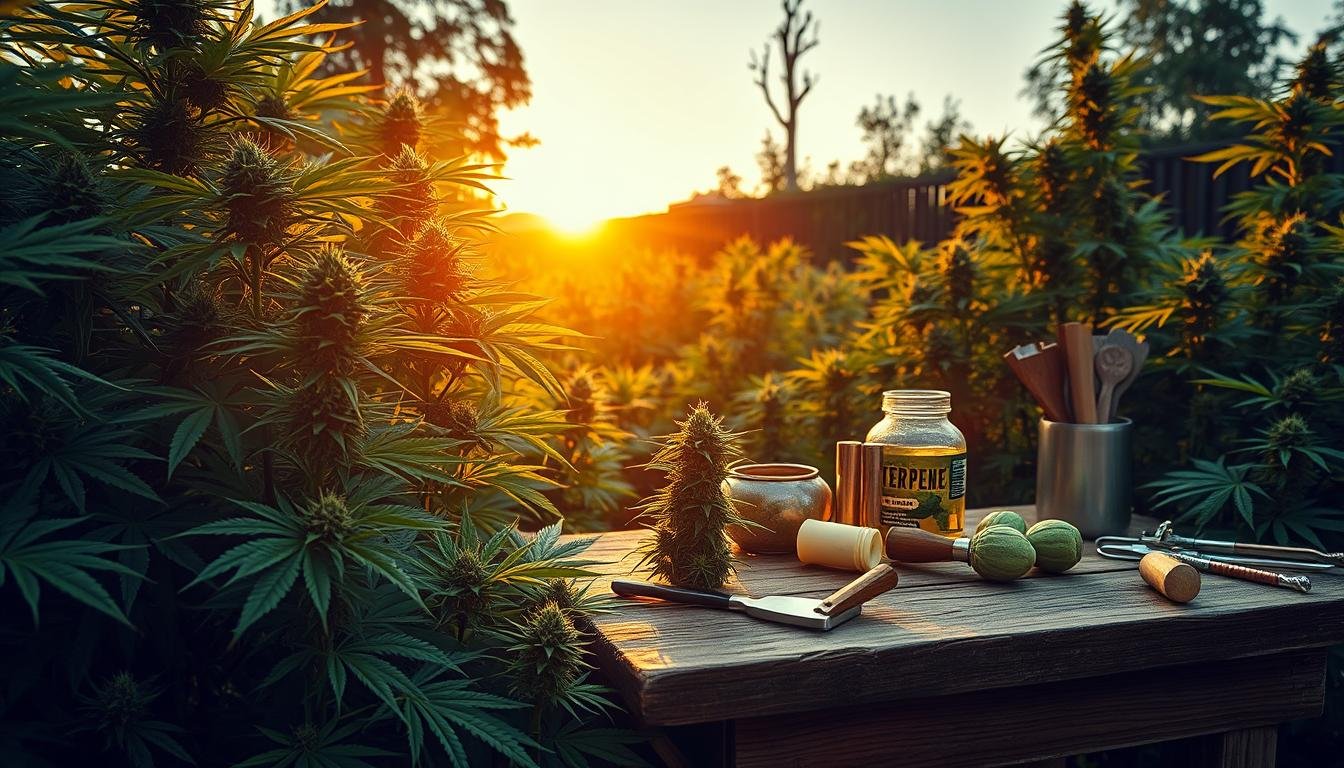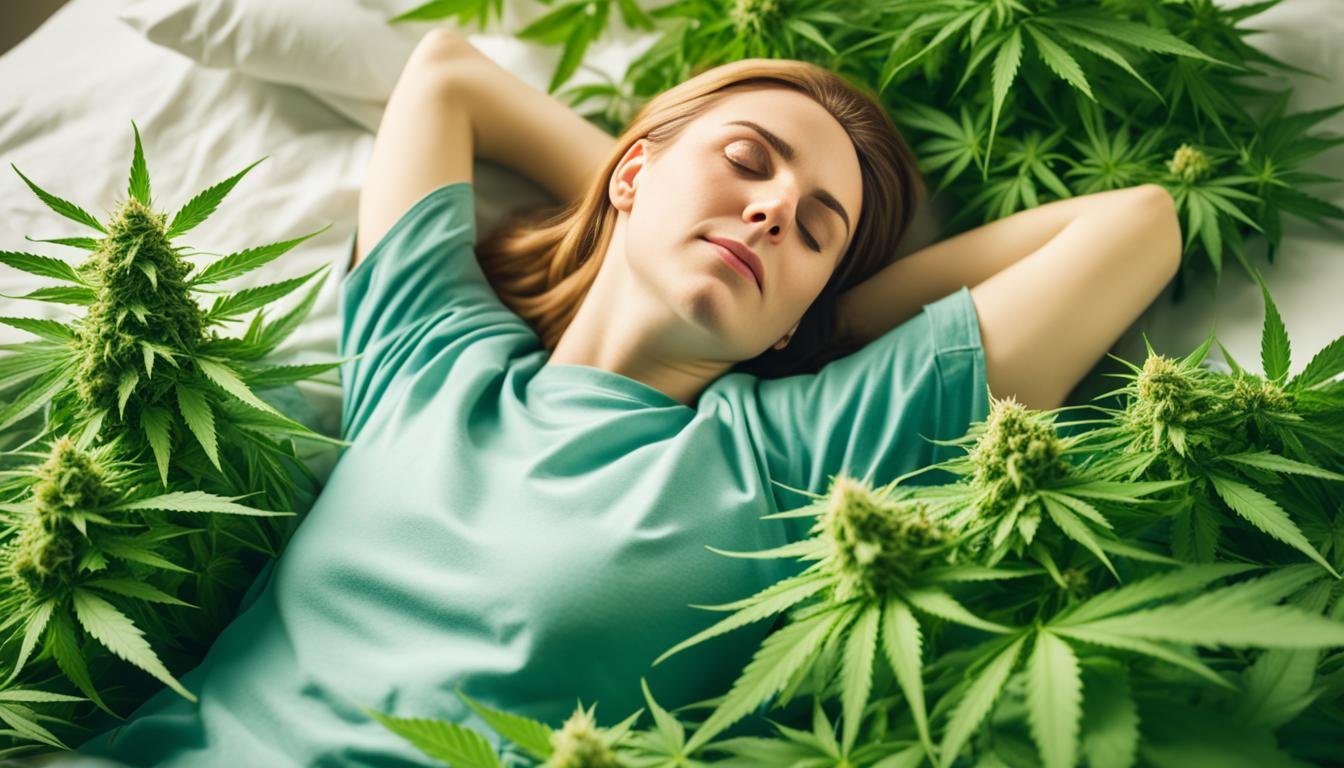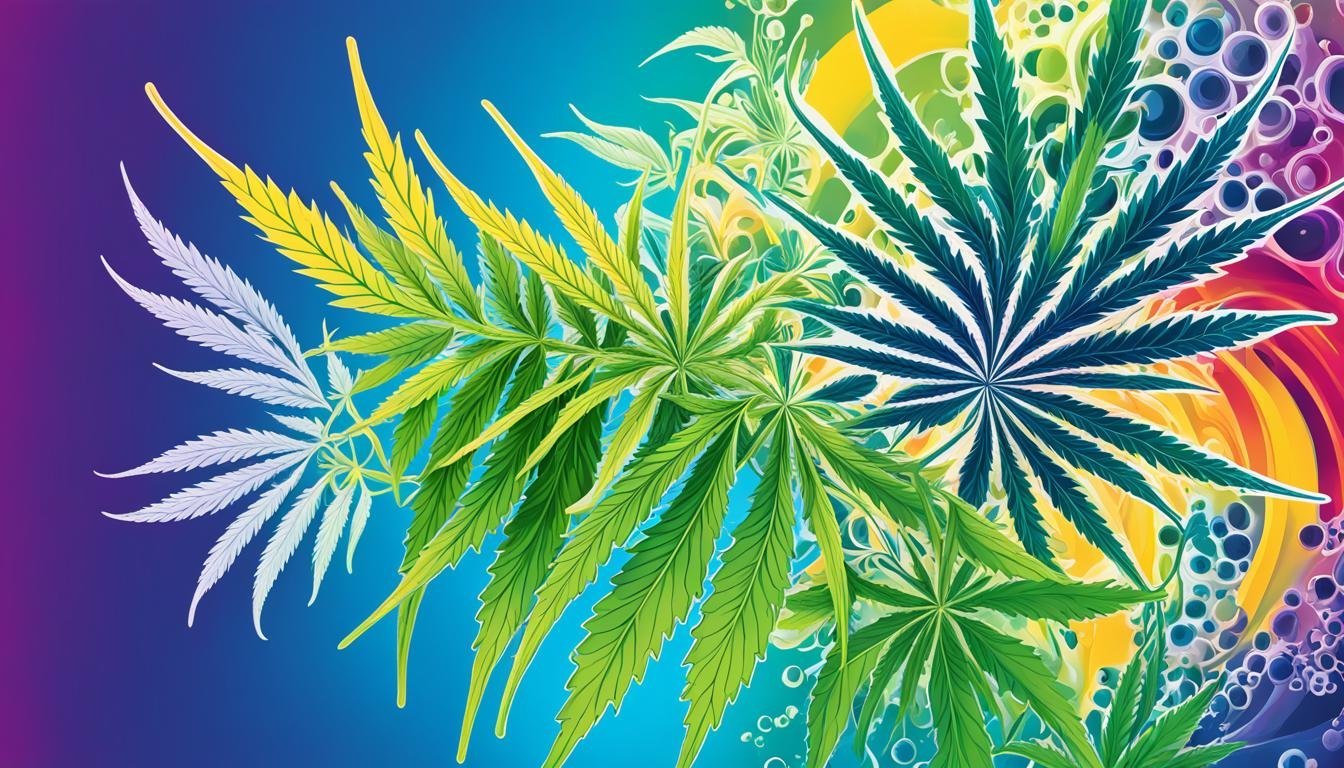The cannabis plant is complex and has been used for centuries. Harvesting it for medicine needs care to get the best results. This guide will show you how to harvest medicinal cannabis well.
It covers checking when to harvest, drying, and storing. You’ll also learn about legal and safety rules. Plus, how to get the most from your cannabis.
Key Takeaways
- Understand the cannabis plant’s anatomy and life cycle to identify optimal harvest timing.
- Monitor trichome color and pistil changes to determine when to harvest for maximum potency.
- Explore hand-trimming and machine-trimming techniques for efficient, high-quality harvesting.
- Learn the importance of proper drying and curing methods for optimal cannabinoid and flavor profiles.
- Familiarize yourself with legal requirements and safety guidelines in your area.
Understanding Cannabis Plant Anatomy and Life Cycle
Learning about the cannabis plant’s anatomy is key for growers. The plant’s structure supports many functions, like energy creation and reproduction. Knowing each part’s role helps growers track the plant’s growth and ensure it reaches its best.
Cannabis Plant Structure and Functions
The cannabis plant has several important parts. Roots anchor the plant and take in nutrients and water. Stems support the plant and carry nutrients and water. Leaves are the powerhouses, turning sunlight into energy for the plant.
Identifying Male and Female Plants
Cannabis plants are either male or female. Males produce pollen, while females have resin-rich buds. Knowing a plant’s sex is important, as growers focus on females for their valuable cannabinoids.
Growth Stages and Maturity
The cannabis plant goes through different stages from seed to harvest. Watching these stages helps growers know when to harvest. Signs like trichome color and pistil changes show when the plant is ready.
| Growth Stage | Characteristics |
|---|---|
| Seedling | Emergence of the first true leaves and root system establishment |
| Vegetative | Rapid growth of leaves, stems, and branches |
| Flowering | Development of flowers and resin production |
Understanding cannabis plant anatomy and life cycle helps growers succeed. This knowledge is crucial for tracking plant progress and knowing when to harvest.
Monitoring Plant Readiness for Harvest
Knowing when to harvest your cannabis is key to getting the best quality. Watching your plants’ trichomes and pistils can tell you when they’re ready. This helps you get the most out of your crop.
Observing Trichome Color and Pistil Changes
Trichome color is a top sign of when to harvest. They start clear and turn amber or milky as they mature. Harvest when most trichomes are milky or amber for the best cannabinoids.
Also, look at the pistils. They change from white to reddish-brown as the plant gets ready. When most pistils are dark and curled, it’s time to harvest.
Strain-Specific Flowering Times
Every cannabis strain grows at its own pace. Some take just 8 weeks, while others need 16 weeks or more. Knowing your strain’s typical time helps plan your harvest. Remember, light, temperature, and humidity can also affect growth.
| Strain | Flowering Time (Weeks) |
|---|---|
| Sour Diesel | 10-12 |
| Blue Dream | 9-11 |
| Critical Kush | 8-10 |
| Gorilla Glue | 8-10 |
By watching trichome color, pistil changes, and knowing your strain’s growth, you can harvest at the perfect time. This ensures your cannabis is of the highest quality and potency.
Harvesting Techniques
There are several ways to harvest medicinal cannabis, each with its own benefits and drawbacks. Choosing between hand-trimming and machine-trimming, and dry trimming and wet trimming, can greatly affect the quality and yield of your crop.
Hand-Trimming vs. Machine-Trimming
Hand-trimming is a precise and delicate method that helps preserve the valuable trichomes. However, it’s time-consuming and labor-intensive. Machine-trimming is faster but might damage trichomes, leading to a less refined product.
Dry Trimming vs. Wet Trimming
- Dry trimming removes leaves and stems after drying, when the plant is brittle.
- Wet trimming is done right after harvesting, when the plant is fresh and pliable.
Dry trimming can make the cannabis look cleaner, but it might lose terpenes and cannabinoids. Wet trimming helps keep these compounds better but can be messy. The choice depends on what you want your final product to look like.
| Trimming Technique | Advantages | Disadvantages |
|---|---|---|
| Hand-Trimming |
|
|
| Machine-Trimming |
|
|
| Dry Trimming |
|
|
| Wet Trimming |
|
|
The choice between hand-trimming, machine-trimming, dry trimming, and wet trimming depends on your goals and preferences. Knowing the pros and cons of each method helps growers make the best choice for their needs and desired results.

Drying and Curing Process
Drying and curing cannabis right is key to keeping its quality and benefits. The drying process must be controlled to avoid mold and keep the plant material intact. The curing process boosts the cannabis’s potency and taste, making it essential for the best effects.
Importance of Proper Drying
Drying is a vital step in growing cannabis. Bad drying can cause mold, ruining the product’s safety and quality. Growers must watch the temperature, humidity, and air flow to dry properly. This helps keep the cannabis flavor and maximize the potency of the final product.
Curing for Optimal Potency and Flavor
- The curing process slowly dries and ages the cannabis, taking weeks to months.
- During curing, cannabinoids and terpenes grow, improving the potency and flavor of the final product.
- Good curing softens harsh or grassy tastes in fresh cannabis, making the cannabis flavor profile smoother and more complex.
- Curing also lowers the cannabis’s moisture, making it less likely to grow mold or bacteria.
By managing the drying and curing processes well, growers can make sure their cannabis stays optimal potency and flavor. This gives consumers a top-notch, high-quality product.

| Drying Process | Curing Process |
|---|---|
| – Prevents mold growth – Maintains plant integrity – Preserves cannabis flavor |
– Enhances potency – Develops complex flavor profiles – Reduces moisture content |
Harvesting Medicinal Cannabis
Harvesting medicinal cannabis needs careful attention. It must meet strict quality and regulatory standards for medical use. Unlike recreational cannabis, growing medicinal cannabis requires a detailed approach to harvesting, drying, and curing.
Timing is crucial when harvesting medicinal cannabis. Growers must watch the plant’s trichome and pistil changes. This helps find the best time to harvest, ensuring the highest potency and quality.
Harvesting techniques for medicinal cannabis harvest are different from recreational use. Growers focus on gentle handling and precise trimming. This helps keep the plant material pure and intact. They might use hand-trimming, machine-trimming, dry trimming, or wet trimming, depending on the strain and desired outcome.
| Harvesting Technique | Advantages | Disadvantages |
|---|---|---|
| Hand-Trimming | Allows for precise control and minimizes damage to trichomes | More time-consuming and labor-intensive |
| Machine-Trimming | Faster and more efficient for large-scale operations | Potential for more trichome damage and less control |
| Dry Trimming | Preserves terpene profile and potency | Requires more drying time and careful handling |
| Wet Trimming | Faster and easier to handle | May result in some terpene and cannabinoid loss |
The goal in harvesting medicinal cannabis is to find a balance. It’s about being efficient, maintaining quality, and following regulations. This ensures the final product is up to the standards of a therapeutic substance.

Essential Tools and Equipment
Harvesting, drying, and storing medicinal cannabis need special tools. You’ll need drying racks, storage containers, and trimming tools. The right tools are key to keeping your cannabis quality and potency high.
Drying Racks and Storage Containers
Drying and curing are vital steps. Cannabis drying racks help buds dry evenly. Choose racks made from durable, rust-proof materials like stainless steel or aluminum.
For cannabis storage containers, go for airtight, UV-resistant ones. They keep your dried cannabis fresh and potent.
Trimming Tools and Accessories
Trimming needs the right cannabis trimming tools. Quality scissors, made for trimming cannabis, make the job easier and more precise. Tools like magnifying glasses and trays also improve the trimming process.
| Tool/Equipment | Key Features | Recommended Products |
|---|---|---|
| Cannabis Drying Racks | Sturdy, rust-resistant construction, efficient air circulation | XYZ Stainless Steel Drying Rack, ABC Aluminum Drying Rack |
| Cannabis Storage Containers | Airtight, UV-resistant, maintain freshness and potency | PQR Airtight Glass Jars, STU Opaque Plastic Containers |
| Cannabis Trimming Tools | High-quality scissors, magnifying glasses, trimming trays | VWX Precision Scissors, YZA Trimming Tray with Magnifier |
Getting the right cannabis harvesting tools, cannabis drying racks, cannabis storage containers, and cannabis trimming tools is crucial. They help you get the best from your medicinal cannabis. With the right equipment, your buds will be perfectly dried, cured, and preserved.

Legal Considerations and Safety Guidelines
Harvesting medicinal cannabis needs careful following of laws and safety steps. Growers must know the legal considerations for harvesting cannabis and cannabis harvesting safety to keep the process safe and legal.
In the United States, cannabis cultivation regulations change a lot from state to state. Growers need to learn the laws about growing, selling, and using cannabis in their area. This includes getting the right licenses and following rules on how many plants you can grow and how big your growing area can be.
- Get all needed licenses and permits for growing and harvesting cannabis.
- Follow state and local laws on how many plants you can grow and how big your growing area can be.
- Use strong security, like cameras and limited access, to stop theft and keep the cannabis safe.
- Handle, store, and move the cannabis carefully to keep its quality and track where it comes from.
- Know the rules for selling, distributing, and processing the cannabis you harvest.
Cannabis harvesting safety is very important too. Growers must protect themselves and their workers while harvesting. This means wearing the right protective gear, handling the plants safely, and keeping the area clean and organized.
| Safety Measure | Importance |
|---|---|
| Wearing gloves, goggles, and respirators | Keeps you safe from plant materials and possible contaminants |
| Maintaining proper ventilation and airflow | Helps avoid breathing problems and keeps you safe from airborne particles |
| Using safe trimming and handling methods | Prevents injuries and keeps the cannabis in good shape |
| Storing and moving the cannabis properly | Keeps the quality and strength of the final product |
By knowing and following the legal considerations for harvesting cannabis and cannabis harvesting safety rules, growers can have a successful and legal cannabis harvest.
Maximizing Yield and Potency
Cannabis growers aim to make high-quality medicine. They need to know what affects yield and potency. This includes environmental factors and specific growing techniques. These strategies can improve the cannabis harvest’s quality and amount.
Environmental Factors Affecting Yield
The environment greatly impacts cannabis growth. Important factors are temperature, humidity, light, and soil quality. Keeping these conditions right can increase cannabis yield and lead to a bigger harvest.
Techniques to Boost Cannabinoid Content
Growers can also use techniques to boost potency and cannabinoid content. Techniques like selective breeding, adjusting light, and stress-inducing methods help. These methods can enhance valuable cannabinoids like THC and CBD.
| Technique | Description | Impact on Cannabinoid Content |
|---|---|---|
| Selective Breeding | Carefully selecting parent plants with desirable traits to produce offspring with higher cannabinoid levels | Can significantly increase the potency and cannabinoid content of the final product |
| Light Spectrum Manipulation | Adjusting the intensity and wavelength of light during different growth stages to stimulate cannabinoid production | Can help maximize the production of specific cannabinoids, such as THC or CBD |
| Stress-Inducing Strategies | Deliberately exposing plants to controlled stress factors, such as temperature fluctuations or nutrient deficiencies, to trigger an increase in cannabinoid synthesis | Can lead to a significant boost in overall cannabinoid content, though careful management is required to avoid compromising plant health |
By using these strategies, growers can maximize yield and potency. This ensures a consistent and high-quality product for patients and customers.
Troubleshooting Common Issues
Cannabis growers sometimes face problems during harvesting and after. This section helps solve issues like preventing mold growth during drying and dealing with pests and diseases.
Preventing Mold During Drying
Mold can ruin the quality and safety of cannabis. To stop mold, keep the drying area’s temperature, humidity, and airflow right. Good air flow and watching humidity levels are key. Also, make sure the drying area is clean and free of things that can grow mold.
Dealing with Pests and Diseases
Cannabis crops can get pests and diseases that harm them. Problems like spider mites, powdery mildew, and botrytis are common. To fight pests, check plants often and use natural controls. Catching diseases early helps stop them from spreading and hurting the plants.
| Common Cannabis Pests | Symptoms | Management Strategies |
|---|---|---|
| Spider Mites | Yellowing or mottled leaves, webbing on the underside of leaves | Use of predatory mites, insecticidal soaps, or neem oil |
| Powdery Mildew | White, powdery growth on leaves and stems | Employ fungicides, increase air circulation, and maintain optimal humidity levels |
| Botrytis (Bud Rot) | Gray, fuzzy growth on buds and flowers | Implement preventive measures, such as pruning affected areas and managing humidity |
By tackling these issues early, growers can get a healthy, top-quality harvest. This way, they avoid cannabis diseases and dealing with cannabis pests.
Utilizing Cannabis Trim
The cannabis plant offers many products, and trim is one of them. It can be turned into edibles, topicals, oils, and concentrates. This way, we can use every part of the plant.
Making Edibles and Topicals
Cannabis trim is great for making edibles and topicals. It can be mixed into foods and drinks, giving them using cannabis trim benefits. It’s also good for making cannabis topicals like lotions and balms. These products offer relief right where you need it.
Extracting Oils and Concentrates
Cannabis trim is perfect for making oils and concentrates. Through cannabis oil extraction and making cannabis concentrates, it becomes very potent. These extracts are great for vaping, dabbing, and making tinctures.
| Product | Advantages | Potential Uses |
|---|---|---|
| Cannabis Edibles | Discreet consumption, long-lasting effects | Baked goods, candies, beverages |
| Cannabis Topicals | Targeted relief, non-psychoactive | Lotions, salves, balms |
| Cannabis Oils and Concentrates | Potent effects, versatile applications | Vaping, dabbing, tinctures |
By using cannabis trim in different ways, we can make the most of the plant. This approach reduces waste and offers a full range of cannabis products.
Conclusion
This guide has covered the key steps for harvesting medicinal cannabis. It shows how to understand the plant, check its readiness, and use the best methods. It also talks about following the law and keeping things safe.
Growers can get high-quality cannabis by following these steps. This guide is a great help for those growing at home.
The main points are about knowing male and female plants. Also, watching trichome color and pistil changes to know when to harvest. It also covers dry and wet trimming, and how to dry and cure the cannabis right.
By using the steps in this guide, you can harvest medicinal cannabis legally and well. You’ll get the best results and follow all the rules. This guide is a complete summary of what you need to know for growing medicinal cannabis at home.
FAQ
When is the optimal time to harvest medicinal cannabis?
What are the different techniques for harvesting and trimming cannabis?
Why is the drying and curing process important for medicinal cannabis?
What legal considerations and safety guidelines must be followed when harvesting medicinal cannabis?
How can growers maximize the yield and potency of their medicinal cannabis harvest?
How can growers address common issues during the harvesting and post-harvest processes?
What are the benefits of utilizing cannabis trim?
Source Links
- https://jcannabisresearch.biomedcentral.com/articles/10.1186/s42238-021-00087-9 – Processing and extraction methods of medicinal cannabis: a narrative review – Journal of Cannabis Research
- https://cannabis.ny.gov/system/files/documents/2022/10/medical-home-cultivation-guide-.pdf – PDF
- https://www.routledge.com/Cannabis-A-Complete-Guide/Small/p/book/9781032097404?srsltid=AfmBOooe3IOgzW2Sxj4KkPw3sr-CU0QUq1dHZCyhb4PodXzLdSzfQP6L – Cannabis: A Complete Guide



